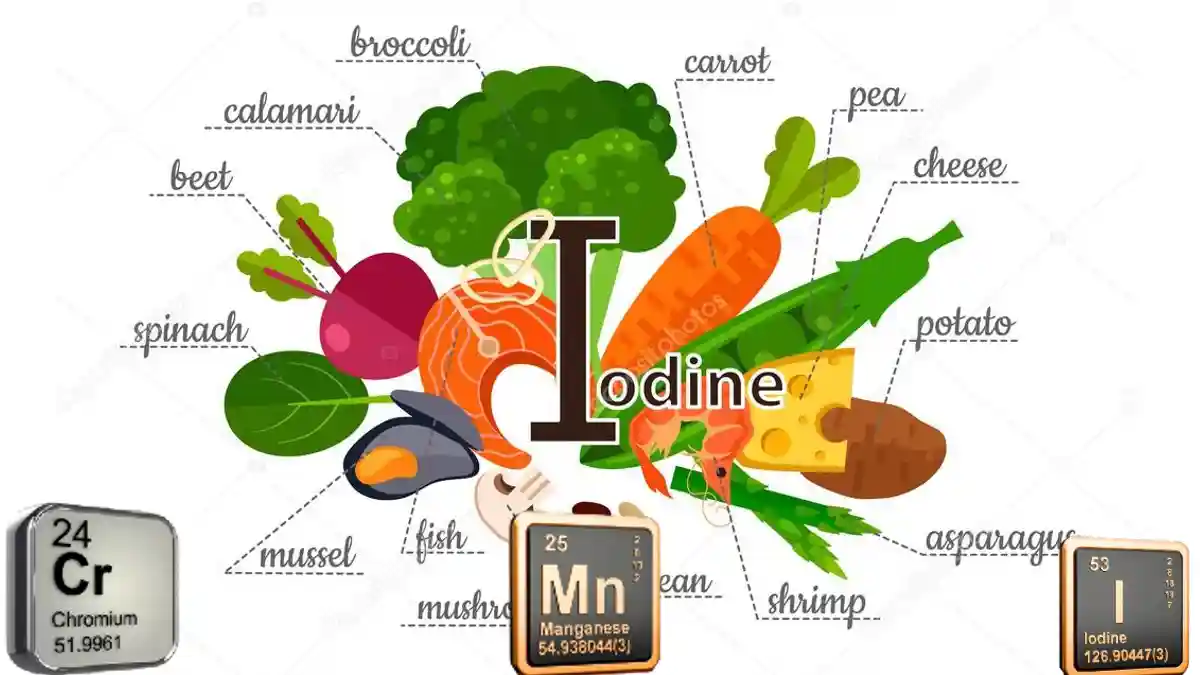Iodine Chromium Manganese
അയോഡിൻ
നല്ല ആരോഗ്യത്തിന് അത്യന്താപേക്ഷിതമായ ആദ്യത്തെ ധാതുക്കളിൽ ഒന്നാണ് അയോഡിൻ. നമ്മുടെ ശരീരത്തിൽ സാധാരണയായി 20-30 മില്ലിഗ്രാം അയോഡിൻ അടങ്ങിയിട്ടുണ്ട്, അതിൽ 60% തൈറോയ്ഡ് ഗ്രന്ഥിയിലും ബാക്കിയുള്ളവ എല്ലാ ടിഷ്യൂകളിലും വ്യാപിക്കുന്നു.


പ്രവർത്തനങ്ങൾ
തൈറോയ്ഡ് ഹോർമോണുകളുടെ പ്രധാന ഘടകമാണ് അയോഡിൻ – ടി & ടി, അവയുടെ ഉത്പാദനത്തിന് ആവശ്യമാണ്. തൈറോയ്ഡ് ഹോർമോണുകൾ ഊർജ ഉൽപ്പാദന നിരക്കും ശരീരഭാരവും നിയന്ത്രിക്കുന്നു. ഗർഭാവസ്ഥയിൽ ഗര്ഭപിണ്ഡത്തിൻ്റെ വളർച്ചയിലും വികാസത്തിലും അയോഡിൻ വളരെ പ്രധാനപ്പെട്ട പങ്ക് വഹിക്കുന്നു.
കുറവ് ലക്ഷണങ്ങൾ
അയോഡിൻ ആഗിരണം ചെയ്യുന്നതിനെ തടസ്സപ്പെടുത്തുന്ന ചില സംയുക്തങ്ങളുടെ സാന്നിധ്യം കാരണം ലോഡിൻ കുറവ് സംഭവിക്കുന്നു. അത്തരം സംയുക്തങ്ങളെ ഗോയിട്രോജൻ എന്ന് വിളിക്കുന്നു. ഉദാഹരണങ്ങളിൽ കാബേജ്, കോളിഫ്ലവർ, റാഡിഷ് മുതലായവ ഉൾപ്പെടുന്നു. ലോഡിൻ കുറവ് ഗോയിറ്ററിലേക്ക് നയിക്കുന്നു, അതിൽ തൈറോയ്ഡ് ഗ്രന്ഥി വർദ്ധിക്കുകയും അവയുടെ അളവ് രക്തത്തിൽ കുറവായിരിക്കുമ്പോൾ കൂടുതൽ തൈറോയ്ഡ് ഹോർമോണുകൾ ഉത്പാദിപ്പിക്കാൻ ശ്രമിക്കുകയും ചെയ്യുന്നു. ബുദ്ധിമാന്ദ്യം, വൈകല്യമുള്ള വളർച്ച, മന്ദഗതിയിലുള്ള ഉപാപചയ നിരക്ക്, ശരീരഭാരം, ക്ഷീണം, അലസത, വിഷാദം എന്നിവ ചില കുറവുകളുടെ ലക്ഷണങ്ങളാണ്. ഗർഭാവസ്ഥയിൽ അയോഡിൻറെ കുറവ് ഉണ്ടെങ്കിൽ, അത് ഗർഭച്ഛിദ്രത്തിനും നിശ്ചല ജനനത്തിനും ശിശുക്കളിൽ ജനിതക വൈകല്യങ്ങൾക്കും ഇടയാക്കും.
ഉറവിടങ്ങൾ
സീഫുഡ്, കടൽപ്പായൽ, സോയാബീൻസ്, ചീര, അയോഡൈസ്ഡ് ഉപ്പ്.
ആവശ്യം
സ്ത്രീകൾക്കും പുരുഷന്മാർക്കും പ്രതിദിനം 150 എംസിജി (WHO ശുപാർശ).

ക്രോമിയം

മുതിർന്നവരിൽ ക്രോമിയത്തിൻ്റെ മൊത്തത്തിലുള്ള ഉള്ളടക്കം 5-10 മില്ലിഗ്രാം ആണ്. ഒരു വ്യക്തി പ്രായമാകുമ്പോൾ, ശരീരത്തിൽ ക്രോമിയം കുറവായി നിലനിർത്താൻ അയാൾക്ക് കഴിയും. ഭക്ഷണ ശീലങ്ങളും ജലവിതരണത്തിലെ ക്രോമിയത്തിൻ്റെ അളവും അനുസരിച്ച് ലോകത്തിൻ്റെ വിവിധ ഭാഗങ്ങളിൽ മനുഷ്യ കോശങ്ങളിലെ ക്രോമിയത്തിൻ്റെ സാന്ദ്രത വളരെ വ്യത്യാസപ്പെട്ടിരിക്കുന്നു.
പ്രവർത്തനങ്ങൾ
കോശങ്ങളിലെ ഗ്ലൂക്കോസിൻ്റെ ഉപയോഗത്തിൽ ഇത് ഇൻസുലിനുമായി പ്രവർത്തിക്കുന്നു. ഇത് ഇൻസുലിൻ ഫലപ്രാപ്തി മെച്ചപ്പെടുത്തുന്നു, അതുവഴി കോശങ്ങൾ ഗ്ലൂക്കോസിൻ്റെ ഉപയോഗത്തിനും ഊർജ്ജ ഉൽപാദനത്തിനും വേണ്ടിയുള്ള ആഗിരണം വർദ്ധിപ്പിക്കുന്നു. അതിനാൽ, രക്തത്തിലെ ഗ്ലൂക്കോസിൻ്റെ അളവ് കുറയ്ക്കുന്നതിൽ ക്രോമിയം ഒരു പങ്കു വഹിക്കുന്നു. കാർബോഹൈഡ്രേറ്റുകളുടെയും കൊഴുപ്പുകളുടെയും മെറ്റബോളിസത്തിനും ക്രോമിയം പ്രധാനമാണ്.
കുറവ് ലക്ഷണങ്ങൾ
ക്രോമിയത്തിൻ്റെ കുറവ് രക്തത്തിലെ ഗ്ലൂക്കോസിൻ്റെ അളവ് കൂടുന്നതിനും ആത്യന്തികമായി പ്രമേഹത്തിനും കാരണമാകും.
ഉറവിടങ്ങൾ
ക്രോമിയത്തിൻ്റെ പ്രധാന ഉറവിടങ്ങൾ ബ്രൂവറിൻ്റെ യീസ്റ്റ്, ബീറ്റൽ ഇലകൾ, സുഗന്ധവ്യഞ്ജനങ്ങൾ, പരിപ്പ് എന്നിവയാണ്.
ആവശ്യം
സ്ത്രീകൾക്കും പുരുഷന്മാർക്കും പ്രതിദിനം 33 എംസിജി (WHO ശുപാർശ). പ്രമേഹമുള്ളവർ രക്തത്തിലെ ഗ്ലൂക്കോസിൻ്റെ അളവ് നിയന്ത്രിക്കാൻ സപ്ലിമെൻ്റുകളിലൂടെ 200-500 എംസിജി ക്രോമിയം കഴിക്കണം. പ്രമേഹരോഗികൾ അവരുടെ രക്തത്തിലെ ഗ്ലൂക്കോസിൻ്റെ അളവ്, പ്രത്യേകിച്ച് HbA1c ഓരോ 3 മാസത്തിലും ഒരിക്കൽ അവരുടെ രക്തത്തിലെ ഗ്ലൂക്കോസിൻ്റെ അളവ് പരിശോധിക്കണം.
മാംഗനീസ്

മാംഗനീസ് ശരീരത്തിൽ ഒരു ലാഞ്ഛന ഘടകമായി കാണപ്പെടുന്നു, അത് ജീവിതത്തിന് അത്യന്താപേക്ഷിതമാണ്. മനുഷ്യ ശരീരത്തിൽ ഈ മൂലകത്തിൻ്റെ 10-20 മില്ലിഗ്രാം അടങ്ങിയിരിക്കുന്നു, ഇത് ടിഷ്യൂകളിലുടനീളം വ്യാപകമായി വിതരണം ചെയ്യപ്പെടുന്നു. നമ്മുടെ ഭക്ഷണത്തിൽ അടങ്ങിയിരിക്കുന്ന മാംഗനീസിൻ്റെ 3-4% മാത്രമേ കുടലിൽ നിന്ന് ആഗിരണം ചെയ്യപ്പെടുകയും രക്തത്തിലെത്തുകയും ചെയ്യുന്നു.
പ്രവർത്തനങ്ങൾ
കാർബോഹൈഡ്രേറ്റ്, പ്രോട്ടീൻ, കൊഴുപ്പ് എന്നിവയുടെ മെറ്റബോളിസത്തിൽ നടക്കുന്ന വിവിധ ജൈവ പ്രതിപ്രവർത്തനങ്ങളിൽ മാംഗനീസ് വളരെ പ്രധാനപ്പെട്ട ഘടകമായി പ്രവർത്തിക്കുന്നു. ഹീമോഗ്ലോബിൻ സമന്വയം, അസ്ഥികളുടെ രൂപീകരണം, വളർച്ച, പുനരുൽപാദനം തുടങ്ങിയ നിരവധി ശരീര പ്രക്രിയകൾക്ക് മാംഗനീസ് ആവശ്യമാണ്. ഇത് കോശങ്ങളെ കേടുപാടുകളിൽ നിന്ന് സംരക്ഷിക്കുകയും ചെയ്യുന്നു.

കുറവ് ലക്ഷണങ്ങൾ
മാംഗനീസിൻ്റെ കുറവ് കാർബോഹൈഡ്രേറ്റുകളുടെയും കൊഴുപ്പുകളുടെയും ഉപയോഗക്കുറവ്, ഊർജത്തിൻ്റെ അഭാവം, കുറഞ്ഞ ഹീമോഗ്ലോബിൻ്റെ അളവ്, അസ്ഥി ധാതുവൽക്കരണത്തിലെ അസാധാരണത, വളർച്ചക്കുറവ്, വന്ധ്യത എന്നിവയിലേക്ക് നയിച്ചേക്കാം.
ഉറവിടങ്ങൾ
പരിപ്പ്, വിത്തുകൾ, മധുരക്കിഴങ്ങ്, മത്തങ്ങ വിത്തുകൾ, ടോഫു എന്നിവ മാംഗനീസിൻ്റെ നല്ല ഉറവിടങ്ങളാണ്.
ആവശ്യം
സ്ത്രീകൾക്കും പുരുഷന്മാർക്കും 3.5 മില്ലിഗ്രാം / ദിവസം (WHO ശുപാർശ).
Iodine
Iodine was one of the first minerals to be recognised as vital for good health. Our body normally contains 20-30 mg of iodine, 60% of which is in the thyroid gland and the rest is diffused throughout all the tissues.


Functions
Iodine is the main component of thyroid hormones- T & T and is needed in their production. Thyroid hormones regulate the rate of energy production and body weight. Iodine plays a very important role in the growth and development of foetus during pregnancy.
Deficiency symptoms
lodine deficiency occurs due to decreased iodine uptake because of the presence of some compounds which interfere with its absorption. Such compounds are called goitrogens. Examples include cabbage, cauliflower, raddish etc. lodine deficiency leads to goitre in which the thyroid gland enlarges in an attempt to produce more thyroid hormones when their levels are low in blood. Some of the deficiency symptoms include mental retardation, impaired growth, slow metabolic rate, weight gain, fatigue, lethargy, depression. If deficiency of iodine exists during pregnancy, it may lead to abortion, still birth and genetic defects among infants.
Sources
Seafood, seaweed, soyabeans, spinach, iodised salt.
Requirement
150 mcg/day for both men and women (WHO recommendation).

Chromium

The total body content of chromium in adults is 5-10 mg. As a person grows older, he is able to retain less chromium in the body. The concentration of chromium in human tissues varies greatly in different parts of the world depending on the dietary habits and on the amount of chromium in water supplies.
Functions
It works with insulin in the utilisation of glucose in the cells. It improves the effectiveness of insulin, thereby increases the uptake of glucose by the cells for utilisation and energy production. Hence, chromium plays a role in lowering the blood glucose levels. Chromium is also important for the metabolism of carbohydrates and fats.
Deficiency symptoms
Deficiency of chromium can lead to high blood glucose levels and ultimately diabetes.
Sources
Main sources of chromium are brewer’s yeast, beetel leaves, spices and nuts.
Requirement
33 mcg/day for both men and women (WHO recommendation). People having diabetes should take 200-500 mcg of chromium through supplements to manage their blood glucose levels. Diabetics should check their blood glucose levels especially HbA1c once in every 3 months to monitor their blood glucose levels.
Manganese

Manganese is found in the body as a trace element and is essential for life. The human body contains 10-20 mg of this element which is widely distributed throughout the tissues. Only 3-4% of the manganese present in our diet gets absorbed from the intestine and reaches the blood.
Functions
Manganese acts as a very important component in various biological reactions that take place in the metabolism of carbohydrates, proteins and fats. Manganese is needed for several body processes like haemoglobin synthesis, bone formation and growth and reproduction. It also protects the cells from damage.

Deficiency symptoms
Deficiency of manganese may lead to impaired utilisation of carbohydrates and fats, lack of energy, low haemoglobin levels, abnormality in bone mineralisation, impaired growth and infertility.
Sources
Nuts, seeds, sweet potatoes, pumpkin seeds, tofu are good sources of manganese.
Requirement
3.5 mg/day for both men and women (WHO recommendation).

